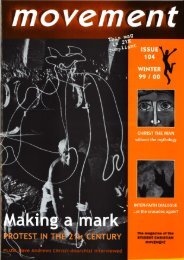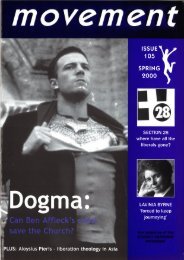Movement 100
You also want an ePaper? Increase the reach of your titles
YUMPU automatically turns print PDFs into web optimized ePapers that Google loves.
\n1974, <strong>Movement</strong> asked: "What is the attraction of Taiz6 and why does it entice thousands to make<br />
the long pilgrimage there? ls this a new spiritual revival or the final carrot coughed up by a dying<br />
church?" During that Easter, <strong>Movement</strong> sent John Gareswell for this personal report<br />
The Phenomenon<br />
of Ta'i ze<br />
c0uer me<br />
BEAUTIFUT<br />
fir"st published in <strong>Movement</strong> 16 0974)<br />
T'<br />
h. past fifteen years has finally seen the demise of<br />
the Church as a major instrument<br />
I<br />
of social control,<br />
particularly in relation to the upbringing of children.<br />
I Even the Catholic church, because of the diminishing<br />
emphasis on a weekly confessional, has lost its grip on the<br />
minds of catholic youth, Where children once learned to<br />
equate the Church with parents, teachers and policemen as<br />
representing a source of control and authority, our<br />
secularised society has found it can safely dispense with<br />
religion as an agent of the conditioning process, hence the<br />
Church, by default-and sometimes by design has lost its<br />
pre-eminent position as a socialising force.<br />
Yet the student-aged population, far from rejoicing in<br />
their,freedom from the stranglehold of the Christian religious<br />
establlshment, are flocking in large numbers to attach<br />
themselves to one ol the many new religious groups<br />
emerging in society. The Church as an outmoded social institution,<br />
peddling meaningless notions of God and irrelevant<br />
patterns of worship, has quite definitely been rejected. But<br />
belief as such, and the ritualisation of belief into some form<br />
of worship, still seems to find favour. From the Christian Union<br />
on the one side, through a spectrum that includes Billy<br />
Graham, Children of God, Divine Light lvlission,<br />
Transcendental Meditation, Zen and ranges out to the occult,<br />
there is a distinct craving to assert religion as a central<br />
feature of life.<br />
Somewhere within this new religious spectrum the<br />
monastic community at Taiz6 is placed; a community which is<br />
exerting such an incredible pull on the imaginaiion of young<br />
people throughout western Europe that several thousand of<br />
them pass through Taiz6 each week of the summer, and at<br />
Easter nearly 20,000 come together to celebrate the<br />
Resurrection of Christ.<br />
The motivaiing force which has driven the Taiz6<br />
Community since its inception in 1949 is a Catholic Workertype<br />
spirit of social and political activism, grounded in a deep<br />
belief in the unifying power of the Body of Christ. The<br />
brothers themselves have three basic commitments: celibacy,<br />
a sharing of all possessions, and acceptance of the Prior's<br />
authority. The Prior, Roger Shultz, first persuaded some<br />
friends to join him in setting up the Community as an attempt<br />
to revive monasticism within the Protestant Churches.<br />
Nowadays brothers join from all denominations and Taize is<br />
closely connected to the Catholic Church and the World<br />
Council of Churches, The broihers engage in a variety of<br />
practical services in the local community and are also<br />
involved in some imaginative cooperative schemes.<br />
Throughout the 1 960s more and more people, particularly<br />
from the younger generation, started arriving at Taiz6 to<br />
share for a short period the spiritual discipline of the<br />
brothers. The Prior has always placed great importance on<br />
prayer as an integral part of a committed Christian life-style.<br />
Three offices are said: early morning, noon and evening.<br />
This pattern remains unchanged, irrespective of the<br />
numbers at Taiz6.<br />
The brothers, possibly promoted by the Prior's enthusiasm<br />
about'the intuitions of youth', intervened ai a crucial<br />
stage in the growth of this spontaneous pilgrimage to Taiz6,<br />
The Letter from Taize was started, circulating amongst<br />
Christian youth throughout the world, and an elaborate<br />
Typically for the<br />
Christian npvements of<br />
the late 60's and early<br />
70's, Jesus was prominently<br />
featured on the<br />
cover of the first 20<br />
issues of lllovarcnt,<br />
racking up a'lmost half<br />
of his 10 cover appearances<br />
overall during<br />
this period.<br />
Not that these were<br />
Sunday School depictions<br />
by any flEans. The cover<br />
of No. 4 (below) with<br />
silhouetted nodern<br />
so1diers standing in for<br />
the Centurions makes its<br />
Vjetnam-era point in a<br />
moving way. The striking<br />
cover of llo. 16 (above),<br />
w'ith its 'intricate<br />
Gustav Dore-like<br />
drawings conprising<br />
Jesus' face was the best<br />
of them, and indeed the<br />
best of lAovarcnt's early<br />
covers.<br />
fnovsfnent <strong>100</strong> 5
















